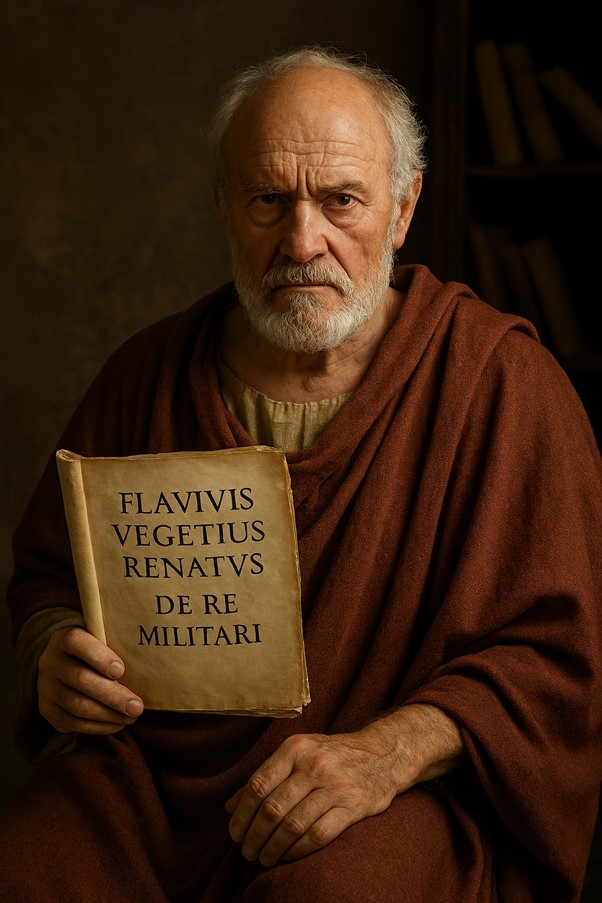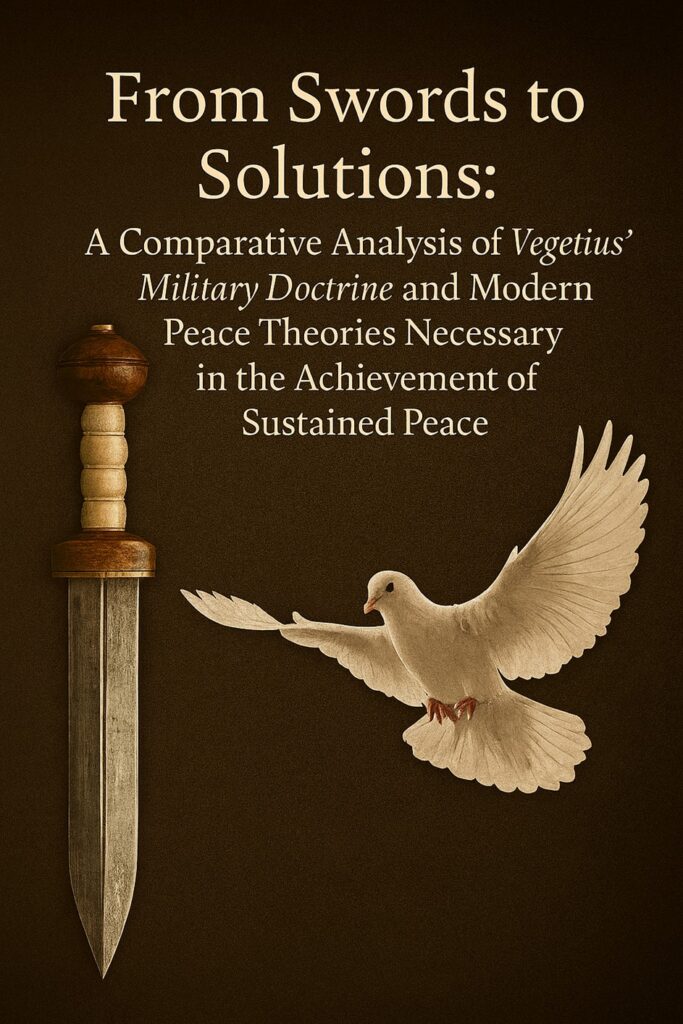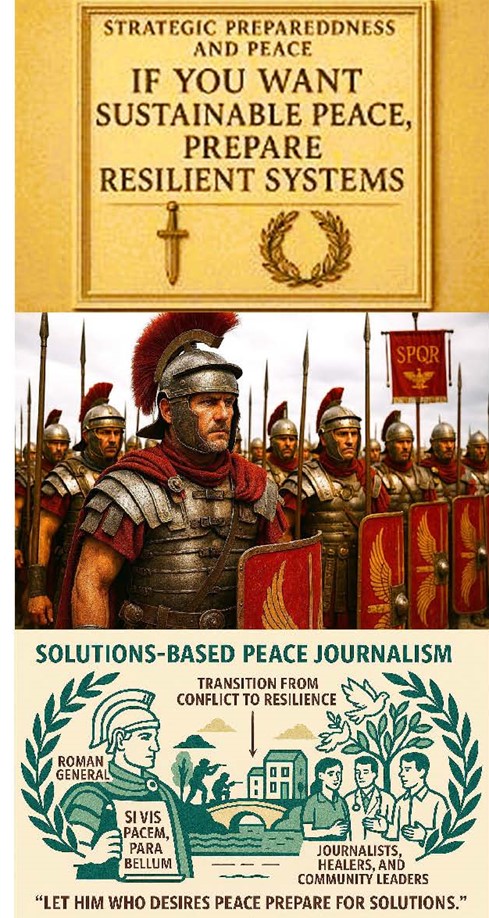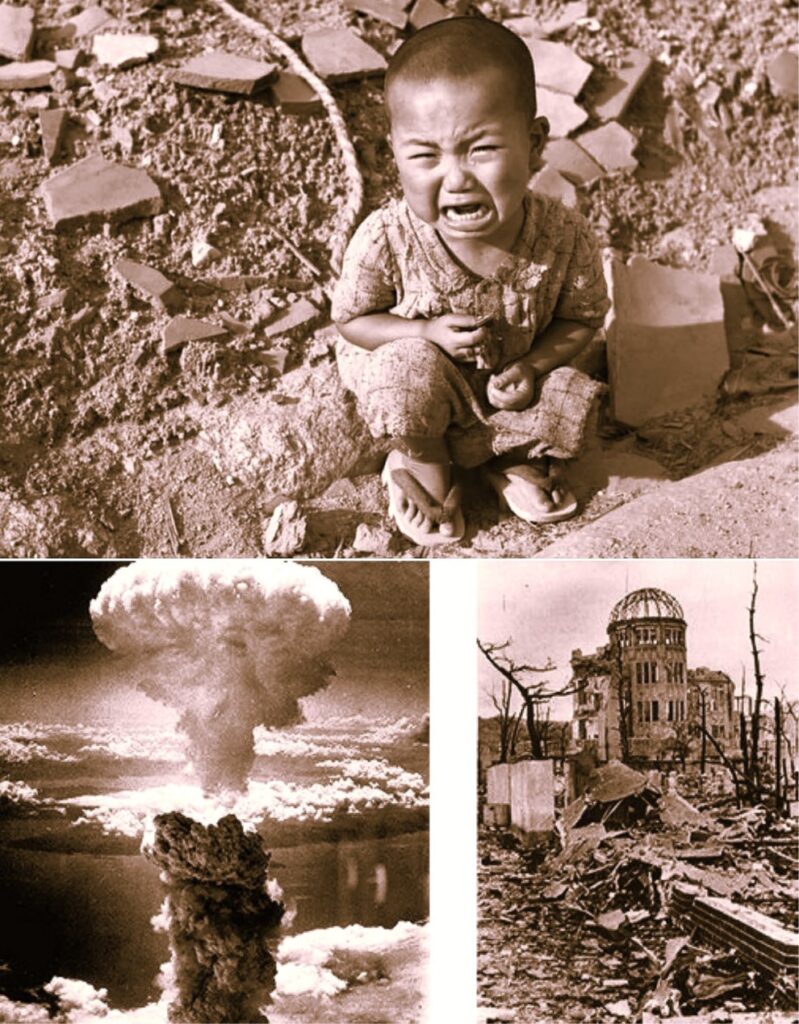From Swords to Solutions: A Comparative Analysis of Vegetius’ Military Doctrine and Modern Peace Theories
TRANSCEND MEMBERS, 1 Sep 2025
Prof Hoosen Vawda – TRANSCEND Media Service
This publication is rated for general readership. Parental guidance is recommended for minors.
********************
Achieving a Sustained Peace
“A comparative analysis of the doctrine of the Roman military writer, General Flavius Vegetius Renatus in his treatise De Re Militari.[1] Vegetius emphasized that military preparedness was essential to deter aggression and maintain peace.”[2]

A recreated image of The Great Roman General, Military Strategist, Writer and Disciplinarian: Flavius Vegetius Renatus, who is seen holding the treatise he composed: “De Re Militari”, in the late 4th century CE, as a response to the deteriorating military standards and prowess of the Roman Empire’s military might.
Photo Credit: Specially commissioned graphic, by the author, from Microsoft Office 365
Prologue
The readers of this paper, who heard Vice-President J.D. Vance [3], deliver his inaugural speech[4], would have realised that the Vice President of the United States, was applying Vegetius’s’[5] Maxim to 21st Century Western Military Policy. Vice President J.D. Vance did indeed allude to the classical military philosophy of Vegetius, particularly the maxim:
“Si vis pacem, para bellum”, “If you want peace, prepare for war.”
This principle was echoed in Vance’s articulation of the Trump Doctrine[6], which he described as:
- Articulating a clear American interest (e.g., preventing Iran from acquiring nuclear weapons),
- Attempting aggressive diplomacy, and
- Using overwhelming military force if diplomacy fails, followed by swift disengagement.
This approach reflects Vegetius’ emphasis on readiness and deterrence as the foundation of peace. Vance framed this doctrine as a modern embodiment of “peace through strength,”[7] a phrase often used by President Trump and rooted in Roman strategic thought.
In his speech at the American Dynamism Summit, Vance also emphasized the importance of technological dominance, industrial revitalization, and national purpose, suggesting that a strong, innovative, and self-reliant America is essential not only for prosperity but also for peace.
While he did not quote Vegetius directly, the philosophical undercurrent of military preparedness as a guarantor of peace was unmistakable, aligning with the author’s peace journalism model’s interest in historical frameworks of conflict resolution.
J.D. Vance Defines the ‘Trump Doctrine’ in TIME magazine time.com[8]
Remarks by the Vice President at the American Dynamism Summit | The Presidency.ucsb.edu, the subtlety of the reference. Integrating Vegetius’ maxim into the TMS, Solutions-Based Peace Journalism (SBPJ)[9] framework in order to enrich it with historical depth and philosophical nuance, in a structured manner.
Integrating Vegetius into SBPJ: A Strategic Peace Lens
- Philosophical Foundation:
- Vegetius’ Maxim: “Si vis pacem, para bellum”, If you want peace, prepare for war.
- SBPJ Interpretation: Reframe this as “If you want sustainable peace, prepare resilient systems.” This shifts the focus from militarism to preparedness in diplomacy, social cohesion, and conflict resolution.
- Strategic Readiness as Peace Infrastructure:
- Highlight that peace journalism must not only report on peace but also anticipate threats and build societal resilience.
- Use Vegetius’ logic to argue that preparedness, in education, healthcare, diplomacy, and media literacy, is essential to prevent conflict.
- Deterrence vs. Dialogue:
- Contrast military deterrence with dialogic deterrence: the idea that robust dialogue, cultural understanding, and inclusive narratives can deter violence.
- SBPJ can advocate for “dialogue readiness”, training journalists and communities to engage constructively before tensions escalate.
- Historical Continuity:
- Position SBPJ as a modern evolution of ancient strategic thought, not rejecting Vegetius, but transforming his principle for a post-conflict, post-colonial world.
- This gives your framework intellectual gravitas and shows its adaptability across eras.
- Peace Through Strength, Redefined:
- Redefine “strength” as moral clarity, institutional integrity, and community solidarity.
- SBPJ can promote stories that show how strong civil societies prevent war — echoing Vegetius’ core idea but with a peace-centric lens.
In the modern context, especially regarding the Western bloc’s increase in nuclear arms and military budgets, this maxim is invoked as a strategic rationale. The author elaborates as to how Vegetius’ doctrine applies and how it is contested, by contemporary peace propagators using the counter maxim: “If you want Peace, prepare for Peace.”[10]
Introduction
The enduring maxim “Si vis pacem, para bellum” “If you want peace, prepare for war” attributed to the Roman military general and strategist, Flavius Vegetius Renatus, has echoed through centuries of military doctrine and statecraft. Rooted in the pragmatic realities of a declining Roman Empire, Vegetius’ treatise De Re Militari argued that peace could only be secured through disciplined military readiness and strategic deterrence. This philosophy has profoundly influenced Western military thinking, from the age of empires to the nuclear doctrines of the 20th and the 21st centuries.
In contrast, the modern era has witnessed the emergence of peace theories that challenge the assumption that war-readiness ensures peace. Thinkers such as Johan Galtung[11],[12], John Paul Lederach[13], and Howard Zehr[14] have redefined peace not merely as the absence of war (negative peace), but as the presence of justice, equity, and human flourishing (positive peace). These theories emphasize reconciliation, structural transformation, and the cultivation of nonviolent relationships, a vision of peace that transcends the logic of deterrence.
This paper explores the philosophical and practical divergence between Vegetius’ militaristic paradigm and contemporary peace theories. It examines how each framework conceptualizes peace, the means by which it is pursued, and the ethical implications of their respective strategies. In doing so, it also considers whether these seemingly opposing worldviews can be reconciled, or whether the future of global peace depends on a decisive shift from preparing for war to preparing for peace.

The Sword of War; ready to kill and the Dove of Peace; ready to effect Sustained Harmony, in Happer times, together.
Photo Credit: Specially commissioned graphic, by the author, from Microsoft Office 365
Vegetius’ Doctrine: Peace Through Preparedness
Flavius Vegetius Renatus, writing in the late 4th century CE, composed De Re Militari as a response to the deteriorating military standards of the Roman Empire. His treatise, widely circulated throughout medieval and Renaissance Europe, became a foundational text for military strategy and statecraft. At its core lies the enduring maxim: “Si vis pacem, para bellum”, “If you want peace, prepare for war.” This principle encapsulates Vegetius’ belief that peace is not a passive condition but a product of vigilance, discipline, and strength.
Vegetius argued that the decline of Rome was due not to external threats alone, but to internal decay particularly the erosion of military discipline and civic responsibility. He advocated for rigorous training, strategic fortification, and the cultivation of a professional standing army. In his view, a nation that neglects its military invites conquest; conversely, a nation that is visibly prepared for war discourages aggression and maintains peace through deterrence.
Key Tenets of Vegetius’ Doctrine
- Military Discipline: The foundation of a strong army lies in the moral and physical conditioning of its soldiers. Vegetius emphasized regular drills, strict hierarchy, and loyalty to command.
- Strategic Readiness: Peace is preserved not by hoping for it, but by preparing for its disruption. Fortifications, logistics, and tactical foresight are essential to national survival.
- Moral Duty of Defence: Vegetius framed military preparedness as a civic virtue. Citizens and leaders alike bear responsibility for the defence of the state.
However, Vegetius’ view is not without critique. It presumes a world of perpetual threat and competition, where peace is always provisional and dependent on force. As such, it offers little guidance for addressing the root causes of conflict or for building peace through reconciliation, humanism and justice; concerns that lie at the heart of modern peace theories.
Historical Applications of Vegetius’ Doctrine
- The Roman Empire (Late Antiquity)
Vegetius’ own context was the declining Western Roman Empire, plagued by internal corruption and external invasions. His treatise was a call to return to the disciplined military ethos of earlier Roman legions, which had secured centuries of Pax Romana — a peace maintained through overwhelming force and strategic dominance.
- The Carolingian and Byzantine Empires
De Re Militari was studied by medieval rulers such as Charlemagne and Byzantine generals, who saw in it a blueprint for restoring imperial strength. The Byzantine military manuals, like the Strategikon[15], echoed Vegetian principles of preparedness and discipline.
- Renaissance and Early Modern Europe
During the Renaissance, military theorists such as Niccolò Machiavelli [16]drew directly from Vegetius. In The Prince, Machiavelli[17] warned that a ruler who neglects military affairs risks losing power, a clear echo of para bellum. European monarchs like Louis XIV of France[18] maintained large standing armies not only for conquest but to deter rebellion and foreign aggression.
Napoleon Bonaparte[21], though a revolutionary figure, embodied the Vegetian ideal of military readiness as a tool of national strength. Later, Carl von Clausewitz’s On War [22]would refine the logic of deterrence and preparedness, emphasizing war as a continuation of politics by other means, a modern echo of Vegetius’ realism.
- Cold War Nuclear Deterrence[23]
The doctrine of Mutually Assured Destruction [24](MAD) during the Cold War is perhaps the most extreme modern application of para bellum[25]. The U.S. and Soviet Union amassed vast nuclear arsenals [26]not to use them, but to deter each other from initiating conflict. Peace, in this context, was maintained by the threat of total annihilation, a grim but potent realization of Vegetius’ logic.
Vegetius’ doctrine has thus shaped centuries of military and political thought. Yet, while it offers a pragmatic approach to national defence, it also assumes a world of perpetual threat and competition. It provides little guidance for addressing the root causes of conflict or for building peace through justice, reconciliation, and human development concerns that lie at the heart of modern peace theories.
Historical Background: Flavius Vegetius Renatus and De Re Militari
Flavius Vegetius Renatus was a Roman military writer active during the late 4th century CE, a time when the Western Roman Empire was in decline. His treatise, De Re Militari (also known as Epitoma Rei Militaris), was written to advise emperors on restoring the strength and discipline of the Roman army. It became one of the most influential military manuals in European history, studied by generals and rulers from Charlemagne to Napoleon.
Vegetius did not write as a soldier but as a scholar and reformer, drawing on earlier Roman military traditions. His work emphasized the importance of training, logistics, leadership, and moral discipline. The treatise was widely copied and translated throughout the Middle Ages and Renaissance, shaping Western military thought for centuries.
Selected Quotes from De Re Militari
- “Si vis pacem, para bellum.”“If you want peace, prepare for war.”
This is the most famous line, encapsulating Vegetius’ belief that peace is best preserved through strength and readiness. - “The strength of the army is the infantry.” Vegetius emphasized the foundational role of foot soldiers, advocating for rigorous training and discipline.
- “Victory in war does not depend entirely upon numbers or mere courage; only skill and discipline will ensure it.” A call for strategic thinking over brute force.
- “No one is more fortunate in war than he who is prepared to meet it.”
Reinforcing the theme of preparedness as a moral and civic duty. - “The main and principal point in war is to secure plenty of provisions.”
— Highlighting the importance of logistics and planning.
Vice President J.D. Vance – Inaugural Remarks Summary
Tone and Themes: J.D. Vance’s speech was celebratory, patriotic, and deeply aligned with President Donald Trump’s populist and nationalist agenda. He emphasized gratitude, unity, and a recommitment to conservative values.
Key Points:
- Gratitude and Victory:
- Vance thanked supporters for making the election “too big to rig,” implying a strong mandate from the American people
- He praised Donald Trump as “the best president this country has had,” highlighting loyalty and admiration for the returning president
- Partnership and Foreign Policy:
- In conversations at the Liberty Ball, Vance discussed international affairs, including border control, European security, and support for Ukraine
- He affirmed the strength of the Anglo-American relationship, calling it “a covenant” rather than just an alliance
- Optimism and Forward-Looking Vision:
- Vance expressed excitement about the future and a commitment to restoring American greatness.
- He echoed Trump’s themes of national pride, competence, and common sense governance.
- Ceremonial Participation:
- Vance and his wife, Usha, joined the Trumps on stage at the Liberty and Commander-in-Chief Balls, participating in symbolic dances and celebrations
- Human Security Paradigm
Emerging from post-Cold War discourse, the human security paradigm shifts the focus from state security to individual wellbeing. Introduced by the United Nations Development Programme (UNDP), it broadens the definition of security to include:
- Economic Security: Freedom from poverty and unemployment.
- Health Security: Access to healthcare and protection from disease.
- Environmental Security: Protection from ecological degradation and climate change.
- Political Security: Freedom from repression and human rights violations.
This paradigm has informed global development goals and humanitarian interventions, emphasizing that peace cannot exist where basic human needs are unmet.
- Peace Journalism & Solutions-Based Approaches
Media plays a critical role in shaping public perception of conflict and peace. Scholars like Jake Lynch and Annabel McGoldrick developed Peace Journalism as a framework for reporting that avoids sensationalism and promotes understanding.
- Constructive Narratives: Peace journalism highlights solutions, gives voice to all parties, and avoids demonizing language.
- The author’s Contribution: The emerging model of Solutions-Based Peace Journalism, which you are developing, builds on this by actively promoting peace initiatives, community resilience, and cultural empathy, especially in contexts like South Africa, where historical wounds and social inequalities persist.
Modern peace theories thus offer a holistic, ethical, and human-centred approach to peace. They challenge the assumption that security must be achieved through force, proposing instead that peace is cultivated through justice, dialogue, and systemic transformation.
III. Modern Peace Theories: Peace Through Justice and Dialogue
In contrast to Vegetius’ militaristic paradigm, modern peace theories redefine peace not as the absence of war, but as the presence of justice, equity, and human flourishing. These theories emerged in response to the devastating global conflicts of the 20th century and the limitations of deterrence-based security. They emphasize that sustainable peace requires addressing the root causes of violence, including poverty, inequality, historical trauma, and systemic injustice, through nonviolent means.
- Positive Peace – Johan Galtung
Norwegian sociologist Johan Galtung, widely regarded as the father of peace studies, introduced the concept of positive peace to distinguish it from negative peace (the mere absence of direct violence). Positive peace refers to the presence of social systems that promote equity, cooperation, and human dignity.
- Structural Violence: Galtung identified hidden forms of violence embedded in social structures, such as poverty, racism, and exclusion, which perpetuate suffering even in the absence of war.
Peacebuilding
- Comparative Analysis: Vegetius vs. Modern Peace Theories
The contrast between Vegetius’ doctrine and modern peace theories reveals two fundamentally different paradigms for understanding and achieving peace. One is rooted in military realism, the other in humanistic idealism. This section compares their core assumptions, goals, and methods, highlighting both their divergences and potential points of synthesis.
- Conceptual Frameworks
| Dimension | Vegetius | Modern Peace Theories |
| Definition of Peace | Absence of war; stability through deterrence | Presence of justice, equity, and human wellbeing |
| Means to Peace | Military preparedness, strategic deterrence | Dialogue, reconciliation, structural transformation |
| Focus of Security | State-centric; national defense | Human-centric; individual and community wellbeing |
| Ethical Basis | Strategic necessity; civic duty | Moral responsibility; human rights and dignity |
| View of Conflict | Inevitable; must be managed through strength | Preventable; rooted in injustice and inequality |
- Philosophical Tensions
Vegetius’ doctrine assumes a world of perpetual threat, where peace is fragile and must be defended through force. It reflects a realist worldview, where power and deterrence are central to international relations. In contrast, modern peace theories adopt a constructivist and normative approach, viewing peace as a social construct that can be cultivated through education, empathy, and systemic reform.
This tension is evident in contemporary policy debates. For example, the expansion of NATO and increased military budgets in Western nations are often justified using Vegetian logic — deterrence against rising threats. Meanwhile, peace theorists argue that such actions may provoke insecurity, escalate arms races, and neglect the deeper causes of conflict.
- Practical Implications
- Military Spending vs. Peace Infrastructure: Vegetius’ model supports high defense spending as a safeguard. Modern peace theories advocate reallocating resources toward education, healthcare, and conflict prevention.
- Nuclear Deterrence vs. Disarmament: The doctrine of Mutually Assured Destruction reflects Vegetius’ logic taken to its extreme. Peace theorists call for nuclear disarmament and treaties that build trust rather than fear.
- Media and Public Perception: Vegetius’ ethos often dominates mainstream narratives, portraying strength as peace. Peace journalism challenges this by promoting stories of reconciliation, community resilience, and nonviolent solutions.
- Toward a Synthesis?
While these paradigms appear opposed, some scholars and practitioners seek a middle path:
- Preventive Diplomacy: Combining strategic foresight with dialogue to prevent conflict before it escalates.
- Civil-Military Cooperation: Using military resources for humanitarian aid, disaster relief, and peacekeeping.
- Education for Peace: Integrating civic responsibility (Vegetius) with empathy and global citizenship (Galtung, Lederach).
The author’s work on Solutions-Based Peace Journalism offers a promising synthesis, acknowledging the realities of conflict while actively promoting constructive, nonviolent responses rooted in cultural understanding and community empowerment.
- Contemporary Relevance
The philosophical tension between Vegetius’ doctrine and modern peace theories is not merely academic, it plays out vividly in the geopolitical strategies and ethical debates of the 21st century. As global powers navigate complex threats ranging from cyber warfare to climate-induced instability, the question of how best to secure peace remains urgent and contested.

A Brutal Sword of War and a Murdered Dove of Peace
Photo Credit: Specially Commissioned graphic, by the author, from Microsoft Office 365
- Western Military Expansion and Deterrence
In recent decades, Western nations, particularly the United States and NATO allies,have significantly increased military spending, citing threats from rising powers such as China and Russia, as well as non-state actors like terrorist networks. The logic underpinning these investments often echoes Vegetius: peace is preserved through strength.
- Nuclear Modernization: The U.S., UK, and France have embarked on costly programs to modernize their nuclear arsenals. These efforts are framed as necessary for deterrence, despite growing calls for disarmament.
- NATO Expansion: The expansion of NATO into Eastern Europe is justified as a stabilizing force, yet it has also been criticized for provoking tensions with Russia — particularly in the context of the Ukraine conflict.
- Defense Budgets: The U.S. defense budget, the largest in the world, continues to grow, with significant allocations for AI-driven warfare, space defense, and cyber capabilities.
These developments reflect a continued reliance on Vegetius’ principle — preparing for war to secure peace — but they also raise ethical and strategic concerns about escalation, miscalculation, and the neglect of peacebuilding alternatives.
- Peacebuilding and Human Security Initiatives
In parallel, international organizations and civil society groups have advanced peace theories rooted in justice and human security:
- United Nations Peacebuilding Commission: Focuses on post-conflict recovery, reconciliation, and institution-building in fragile states.
- Global Peace Index: Developed by the Institute for Economics and Peace, it ranks countries based on indicators of positive peace, including governance, education, and access to justice.
- Grassroots Movements: In regions like sub-Saharan Africa, South Asia, and Latin America, community-led peace initiatives emphasize dialogue, cultural healing, and restorative justice — often in contrast to state-led militarization.
These efforts embody the principles of modern peace theories, demonstrating that peace can be pursued through nonviolent means, even in contexts of deep historical trauma and structural inequality.
- Media and Public Discourse
The media plays a pivotal role in shaping public understanding of peace and conflict. Mainstream coverage often reflects Vegetius’ ethos — emphasizing threats, military responses, and national security. In contrast, peace journalism and solutions-based reporting seek to reframe narratives:
- Conflict Sensitivity: Highlighting root causes and voices from affected communities.
- Constructive Engagement: Promoting stories of reconciliation, diplomacy, and resilience.
- Your Model: The emerging framework of Solutions-Based Peace Journalism, which you are developing, offers a transformative approach — empowering communities to envision peace not as the absence of war, but as the presence of dignity, justice, and cultural empathy.
- The South African Context
In South Africa, the legacy of apartheid, economic inequality, and social fragmentation presents unique challenges to peace. While the state maintains a modest defense posture, the real work of peace is carried out by educators, healers, activists, and journalists — many of whom embody the principles of modern peace theories.
The author’s outreach integrating biophoton theory, cultural dialogue, and medical care, reflects a holistic vision of peace that transcends militaristic logic. It affirms that preparing for peace, not war, is the sacred duty of a nation committed to healing and human dignity.
- Toward a Synthesis of two Concepts?
While Vegetius’ doctrine and modern peace theories appear to represent opposing worldviews, one grounded in strategic realism, the other in ethical idealism, a growing body of thought suggests that elements of both can be integrated into a more nuanced and effective peace paradigm. This synthesis would acknowledge the realities of conflict and the need for security, while also embracing the transformative power of justice, dialogue, and human development.
- Strategic Foresight Meets Ethical Responsibility
- Preventive Diplomacy: Borrowing from Vegetius’ emphasis on preparedness, preventive diplomacy involves anticipating potential conflicts and addressing them before they escalate. This approach combines strategic analysis with peacebuilding tools such as mediation, early warning systems, and inclusive dialogue.
- Resilient Societies: Just as Vegetius advocated for disciplined and fortified states, modern peace theorists emphasize the importance of resilient institutions — not military alone, but educational, judicial, and civic systems that can withstand shocks and foster cohesion.
- Civil-Military Cooperation
- Peacekeeping Missions: UN peacekeeping operations often involve military personnel trained not for combat, but for stabilization, protection of civilians, and support of political processes. This reflects a hybrid model where military presence serves peace rather than war.
- Humanitarian Assistance: Armed forces are increasingly deployed in disaster relief, pandemic response, and infrastructure rebuilding — roles that align with human security goals and demonstrate the potential for military assets to serve peaceful ends.
- Education and Media as Peace Infrastructure
- Peace Education: Integrating civic responsibility (Vegetius) with empathy and global citizenship (Galtung, Lederach) in curricula can cultivate a generation that is both vigilant and compassionate.
- Solutions-Based Peace Journalism: Your model offers a powerful synthesis by reframing conflict narratives to highlight constructive responses, cultural empathy, and community resilience. It respects the need for awareness and preparedness while actively promoting peace as a lived reality.
- Cultural and Spiritual Dimensions
- Ubuntu and Interfaith Dialogue: In the South African context, philosophies like Ubuntu, “I am because we are”, and interfaith collaboration offer pathways to peace that honour both communal strength and spiritual reconciliation.
- Biophoton Peace Hypothesis: The authors[27] evolving hypothesis linking biophotons to peace propagation[28] introduces a novel synthesis of science, spirituality, and evolutionary ethics, suggesting that peace may be a biologically and cosmically embedded imperative.[29]
- Policy Implications
- Balanced Security Strategies: Governments can pursue security policies that combine defence readiness with robust investment in peacebuilding, social justice, and diplomacy.
- Global Governance Reform: Institutions like the UN, AU, and BRICS can champion a dual approach — ensuring collective security while advancing human development and conflict prevention.
This synthesis does not dilute the insights of either paradigm but enriches them. It affirms that peace is not merely the absence of war or the presence of justice — it is the dynamic interplay of vigilance, compassion, and creativity. In this light, the legacy of Vegetius and the vision of modern peace theorists can converge to guide humanity toward a more secure and harmonious future.
VII. Conclusion
The enduring legacy of Flavius Vegetius’ maxim,“If you want peace, prepare for war” — continues to shape global security strategies, particularly within the Western bloc. His doctrine, rooted in the pragmatic realities of a declining empire, offers a compelling rationale for military preparedness as a safeguard against external threats. Yet, as this paper has shown, the Vegetian paradigm, while historically influential, is increasingly challenged by modern peace theories that redefine peace as a condition of justice, dignity, and human flourishing.
Contemporary peace theorists such as Johan Galtung, John Paul Lederach, and Howard Zehr argue that true peace cannot be sustained through deterrence alone. Instead, it must be cultivated through reconciliation, structural transformation, and the protection of human security. These approaches emphasize the ethical imperative to address the root causes of conflict, poverty, exclusion, trauma, and to build societies resilient not through arms, but through empathy, equity, and education.
The comparative analysis reveals that while Vegetius’ doctrine offers strategic clarity, it risks perpetuating cycles of militarization and fear. Modern peace theories, though sometimes dismissed as idealistic, provide a vision of peace that is proactive, inclusive, and sustainable. The synthesis proposed in this paper, integrating strategic foresight with ethical responsibility, offers a pathway toward a more balanced and humane approach to peace.
In the author’s work, as a Peace Propagator, particularly through the development of Solutions-Based Peace Journalism, this synthesis finds practical expression. By reframing narratives, empowering communities, and promoting cultural empathy, the author contributes to a paradigm where peace is not merely defended, but actively nurtured.
Ultimately, the question is not whether we should prepare for war to preserve peace, but whether we can prepare for peace with the same urgency, investment, and sacred commitment. In answering this question, humanity may yet transcend the logic of conflict and embrace the deeper promise of coexistence.

Photo Top: A modified Maxim as an Antidote to Vegetius’s quote: “If you want sustainable peace, prepare Resilient Systems”.
Photo Middle: A highly disciplined and battle ready, Roman legion, in full combat regalia.
Photo Bottom: “Si vis pacem, para bellum: Reframing Strategic Preparedness for Peace in Solutions-Based Journalism”
This visual narrative reinterprets General Vegetius Renatus’ ancient Roman maxim:“If you want peace, prepare for war”, as a modern call for peace-readiness rather than war-readiness. On the left, Vegetius stands as a symbol of strategic foresight, holding the scroll of wisdom. The central bridge represents the transformative journey from conflict to healing, where the tools of war give way to the tools of peace. On the right, peace journalists, traditional healers, and community leaders gather beneath the Tree of Peace, embodying a holistic approach to societal resilience. The laurel wreath encircling the scene honours victory not through conquest, but through collaboration, cultural integration, and the healing of both body and spirit. This image anchors the Solutions-Based Peace Journalism framework in timeless wisdom, urging societies to prepare not for battle, but for the enduring work of peace.
Photo Credit: Specially commissioned graphics, by the author, form Microsoft Office 365
Epilogue
Echoes of the Roman Legion in a World still at War[30]
The journey through peace theories reveals a complex body of insights and evidence from diverse disciplines. From ancient evolutionary traits to modern media strategies, the pursuit of peace remains elusive[31],[32],[33] and a universal aspiration. The contributions of thinkers and practitioners continue to shape a more harmonious world.
In an age where the spectre of war looms not only in trenches and borders but in cyberspace, climate crises, and ideological divides, the ancient voice of Flavius Vegetius still resonates. His maxim, “If you want peace, prepare for war” speaks to a primal instinct for survival,[34] a call to vigilance in the face of uncertainty. Yet, as the world teeters between deterrence and diplomacy, this doctrine must be re-examined through the lens of our shared humanity.
Today’s conflicts are no longer confined to empires and armies; they are embedded in systems of inequality, historical trauma, and ecological collapse. To prepare for peace in this era requires more than weapons, it demands wisdom, compassion, and the courage to confront injustice. Vegetius offers a mirror to our fears; modern peace theories offer a map to our hopes.
The challenge before us is not to choose between strength and serenity, but to forge a synthesis where preparedness includes not only arms, but empathy; not only defence, but dialogue. In this convergence lies the possibility of a peace that is not merely preserved, but profoundly lived.
The Bottom Line
Vegetius’ maxim remains relevant as a strategic warning, but in the 21st century, preparing for peace must mean investing as deeply in justice, reconciliation, and human dignity, as we do in military might. Only then can peace be sacredly sustained in a world yearning for healing.

“If you want War, then prepare for Death”[35]
The aftermath of the nuclear bomb dropped by America on Hiroshima on 06th August 1945
Top picture: A toddler, who has lost all parental support, surrounded by death and total destruction, in Hiroshima on 06th August 1945. Instant Deaths in Hiroshima: Approximately 70,000 to 140,000 people were killed instantly by the atomic bomb dropped on Hiroshima. This immediate death toll was due to the intense heat and blast effects of the bomb, which incinerated or vaporized many victims instantly. In Nagasaki 73,000 perished instantaneously, on 09th August 1945.
Photo Bottom Left: The infamous Mushroom Cloud of death and pulverisation, after the explosion of the Atom Bomb as photographed from the US plane, Enola Gay, which dropped the actual bomb, as a revenge for the Japanese attack on Pearl Harbour.
Photo Bottom Right: The Hiroshima City Hall, in the aftermath of the bomb, still preserved today, as a stark reminder for the destruction of humanity, by United States. Regrettably, this line of action is still prevalent today as demonstrated by American bombings of Afghanistan, Iran, Syria, Yemen, Vietnam, Cambodia and Yemen, killing of millions of civilians
Photo Credit: Wikimedia Commons
[1] https://en.wikipedia.org/wiki/De_re_militari
[2] Author’s Personal quote: August 2025.
[3] https://en.wikipedia.org/wiki/JD_Vance
[4] https://www.youtube.com/watch?v=DPvQJ7zMi50&ntb=1&msockid=54069e6681db11f0abaf5b77809c77dc
[5] https://en.wikipedia.org/wiki/Vegetius
[6] https://time.com/7297452/trump-doctrine-vance-peace-through-strength-america-first-presidents-history/
[7] https://www.bing.com/news/search?q=Peace+Through+Strength,%E2%80%9D&qpvt=peace+through+strength,%E2%80%9D&FORM=EWRE
[8] https://www.bing.com/videos/search?q=J.D.+Vance+Defines+the+%E2%80%98Trump+Doctrine%E2%80%99+in+TIME+magazine+time.com&qpvt=J.D.+Vance+Defines+the+%E2%80%98Trump+Doctrine%E2%80%99+in+TIME+magazine+time.com&FORM=VDRE
[9] https://www.transcend.org/tms/about-peace-journalism/
[10] https://www.transcend.org/tms/2022/04/applicability-of-igitur-qui-desiderat-pacem-praeparet-bellum-to-the-present-context-of-international-belligerence/
[11]https://www.transcend.org/tms/2022/04/peace-the-odyssey-of-the-relentless-pursuit-of-humanoids-of-an-elusive-philosophy-part-1/
[12] https://www.transcend.org/tms/2023/07/stoicism-unveiling-the-elusive-path-to-peace-part-2/
[13] https://www.beyondintractability.org/essay/hierarchical_intervention_levels
[14] https://zehr-institute.org/what-is-rj
[15] https://archive.org/details/mauricesstrategi00maur
[16] https://www.britannica.com/biography/Niccolo-Machiavelli/The-Art-of-War-and-other-writings
[17] https://www.gutenberg.org/ebooks/57037
[18] https://en.wikipedia.org/wiki/Louis_XIV
[19] https://www.britannica.com/biography/Timeline-of-the-Napoleonic-Era-2236094
[20] https://www.militarystrategymagazine.com/article/an-introduction-to-clausewitzian-strategic-theory-general-theory-strategy-and-their-relevance-for-today/#:~:text=Clausewitzian%20strategic%20theory%20starts%20with%20the%20assumption%20that,fought,%20goes%20through%20a%20constant%20process%20of%20change.
[21] https://en.wikipedia.org/wiki/Military_career_of_Napoleon
[22] https://www.bing.com/aclick?ld=e85T0So7stugZFKYOoULPa3jVUCUy0iqiSMC7H68h1D2z_h6UHBVUKoDwVWHeMB0jU5TrQjAzpNdiaE2NeSVAS_hNYN_kqIESiCjz5RcK-ezxFUdJEIAIitN6NMBmjpjG3b0ULZg0sCnlhv17xqG_exOBxJdUQUxKbNdbWka6xRSqWrVyabhiIVxJEExoD51zOrMdrKg&u=aHR0cHMlM2ElMmYlMmZ3d3cuYXVkaW9ib29rcy5jb20lMmZhdWRpb2Jvb2slMmZvbi13YXIlMmY3MzExMDIlM2ZyZWZJZCUzZDQwOTEyJTI2bXNjbGtpZCUzZGY5YmI4YTExZmY3NTFlMTE0NGYzZTJiZDQ3MjFlZjE5&rlid=f9bb8a11ff751e1144f3e2bd4721ef19
[23] https://www.britannica.com/topic/deterrence-political-and-military-strategy
[24] https://www.britannica.com/topic/mutual-assured-destruction
[25] https://etymologyworld.com/item/parabellum
[26] https://compare.edu.vn/compare/how-did-us-and-soviet-nuclear-arsenals-compare/
[27] https://www.transcend.org/tms/2025/08/light-of-life-the-synchronised-biophotons-and-photobionts-a-novel-hypothesis-part-2/
[28] https://www.transcend.org/tms/2025/08/the-attainment-of-peace-a-multidimensional-perspective/
[29] https://www.transcend.org/tms/2025/08/biophotons-and-the-peace-crusade-a-21st-century-manifesto-written-in-light-part-1/
[30] https://roman.mythologyworldwide.com/echoes-of-war-how-roman-myths-resonate-in-modern-warfare/
[31]https://www.transcend.org/tms/2024/01/the-genesis-and-psychotype-of-brutal-and-gruesome-peace-disruptors/
[32]https://www.transcend.org/tms/2022/10/the-pursuit-of-pseudo-peace-part-1-the-religious-odyssey-of-heavenly-bodies-on-earth/
[33]https://www.transcend.org/tms/2021/11/peace-rattler-humanoids-search-for-the-elusive-eternal-life-and-longevity-part-2/
[34] https://compare.edu.vn/compare/how-did-us-and-soviet-nuclear-arsenals-compare/
[35] Personal, modified quote, based on Geneal Renatus’ original maxim “If you want peace, prepare for war”
______________________________________________
 Professor G. Hoosen M. Vawda (Bsc; MBChB; PhD.Wits) is a member of the TRANSCEND Network for Peace Development Environment.
Professor G. Hoosen M. Vawda (Bsc; MBChB; PhD.Wits) is a member of the TRANSCEND Network for Peace Development Environment.
Director: Glastonbury Medical Research Centre; Community Health and Indigent Programme Services; Body Donor Foundation SA.
Principal Investigator: Multinational Clinical Trials
Consultant: Medical and General Research Ethics; Internal Medicine and Clinical Psychiatry:UKZN, Nelson R. Mandela School of Medicine
Executive Member: Inter Religious Council KZN SA
Public Liaison: Medical Misadventures
Activism: Justice for All
Email: vawda@ukzn.ac.za
Tags: Conflict, Culture of Peace, Military, Peace
This article originally appeared on Transcend Media Service (TMS) on 1 Sep 2025.
Anticopyright: Editorials and articles originated on TMS may be freely reprinted, disseminated, translated and used as background material, provided an acknowledgement and link to the source, TMS: From Swords to Solutions: A Comparative Analysis of Vegetius’ Military Doctrine and Modern Peace Theories, is included. Thank you.
If you enjoyed this article, please donate to TMS to join the growing list of TMS Supporters.

This work is licensed under a CC BY-NC 4.0 License.
Join the discussion!
We welcome debate and dissent, but personal — ad hominem — attacks (on authors, other users or any individual), abuse and defamatory language will not be tolerated. Nor will we tolerate attempts to deliberately disrupt discussions. We aim to maintain an inviting space to focus on intelligent interactions and debates.